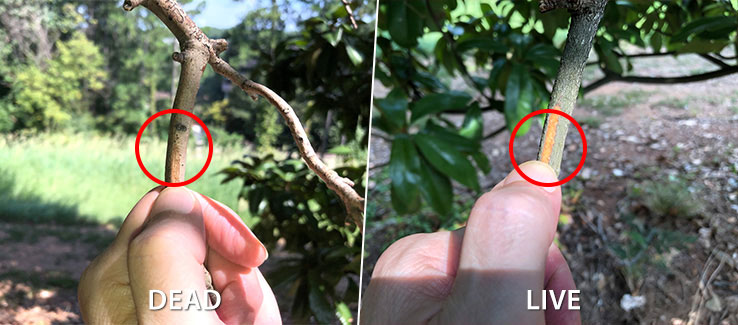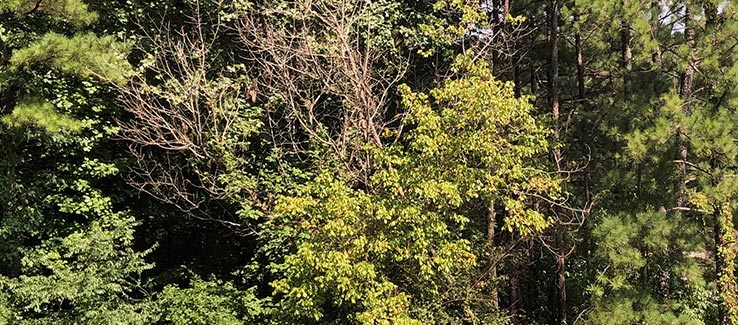
A dying tree is not always obvious, but not knowing the signs is dangerous and may pose a grave risk to people and structures around it. If you can distinguish a troubled or dying tree, you may potentially save yourself from significant loss and costly repairs down the road.
fasttreeremovalatlanta.com gathered the following information to help you discern between a tree that is troubled, dying, or dead and what to do about it.
Is My Tree Dead or Dormant
In late fall and through the winter months, trees may appear to be dead. Deciduous trees, unlike evergreen trees, will lose their leaves and stop growing through the colder months of the year. Here’s how to tell the difference:
1 – Locate a branch or stem to perform a scratch test.
2 – Using a sharp knife, pruning tool, or your fingernail, scratch a very small portion of the bark away.
3 – Examine the tissue just beneath the bark (this is called the cambium tissue).

Green hues and dampness indicate that your tree is alive. Your tree is dying or dead if you encounter dry, brittle, and brown conditions. Repeat the test on another area of the tree to confirm the result.
If your tree is dying or dead, call an arborist to evaluate the tree and recommend a course of action. A dead tree near structures and people poses a series of risks to its surroundings and should be removed immediately.
Leaves Are Changing Colors
In the fall, deciduous trees undergo a phase in which leaves change from green to red, orange, yellow, or brown before falling to the ground (this is normal).
 However, when leaf color changes happen in spring or summer, on any tree (deciduous or evergreen), you have a significant problem on your hands.
However, when leaf color changes happen in spring or summer, on any tree (deciduous or evergreen), you have a significant problem on your hands.
The following are problems that cause off-season leaf color change, wilt, or premature leaf-drop.
Severe Drought – Drought throughout the winter season and into spring can cause severe stress to trees. This stress shows up as:
• Wilting
• Severe dieback
• Leaf color change
• Premature leaf drop
• Successful insect infestation
• Tree death

During drought conditions, increase your watering cycles to maintain the soil around your trees moist. Make sure that trees are mulched. Mulching will help retain soil moisture and prevent roots from drying out.
Boring Insect Infestation – Trees are pretty good at defending themselves from boring insects. However, when a tree is stressed, boring insects are more likely to attack a tree successfully.
Insect infestations cause tree foliage to wilt, change color, grow smaller or deformed, or drop prematurely. Changes can occur in a portion of the crown, or throughout the entire crown depending where the insects have attacked the tree.
The signs of boring insects include:
• Boring dust or sawdust
• Feeding trails or galleries beneath the bark
• Entry or exit holes in the bark
• Actual insects
• Dieback

Treatment for wood boring insects with insecticides is more effective as a preventative measure. Once a successful infestation has occurred, the tree will potentially need extensive pruning. Your best course of action during an infestation is to call an arborist to the location to evaluate the tree, suggest a course of action, and make a threat assessment to surrounding trees and vegetation.
Disease – A diseased tree can appear healthy on one side and dying on the other. There are some disease threats like anthracnose, heart rot, and root rot that can kill a mature tree in a matter of weeks. Below are symptoms to look for:
• Wilting
• Slow leaf growth
• Changing leaf color
• Premature leaf drop

If you suspect that your tree is diseased, have it inspected immediately by a professional tree service. In many cases, a tree can be treated and pruned, allowing it to compartmentalize the disease and continue living.
Girdling – Girdling happens when either compression or bark damage occurs around the circumference of the tree trunk, causing hydraulic failure within the tree. Climbing vines, ropes tied around the tree, vehicle and machinery impacts, or any activity which strips the bark from a tree can cause girdling.

When a tree is girdled, the signs are obvious:
• Leaves will turn yellow or brown and fall from the tree
• Twigs and branches will become brittle
• Signs of disease or insect infestation will likely accompany the death of the tree.
Avoid girdling by:
• Cutting vines off from their roots near the ground (don’t try to remove them from the tree, you may further damage the bark)
• Never tie a rope around a tree trunk
• Avoid vehicle or equipment impacts to the trunk of a tree
If your tree’s bark has been severely damaged, have it inspected by an arborist who can then recommend a course of action.
Root Rot – Root rot can occur from poorly drained soil or disease. The symptoms are very similar to those of girdling:
• Leaves will turn yellow or brown and fall from the tree
• Twigs and branches will become brittle
• Trees with root rot may begin to lean or fall

If you suspect that your tree is dying from root rot, have it inspected immediately. In most cases, the tree will need to be removed.
Do Trees Die of Old Age
Yes. Trees are long-lived but will eventually die from natural causes or human actions. When trees get sick, they can be diagnosed, and with early treatment, pruning, or felling, can be saved or prevented from harming surrounding trees, structures, and people.
How to Avoid Tree Health Problems
One of the best ways to keep your tree healthy throughout its lifetime is to care for it from the time it is planted properly. You can avoid the majority of tree health problems by:
• Knowing the species and its requirements
• Planting it in an optimally lit and protected location
• Giving it proper watering intervals and fertilization
• Making sure the soil meets the needs of the species
• Seasonally pruning unwanted or infected growth
• Protecting its bark from impacts and damaging vines
• Having the tree inspected annually by an arborist
Preventative measures will help you avoid significant tree health issues, along with promoting a healthy ecosystem in your yard or landscape.
Is My Tree Dying
A dead or dying tree is capable of spreading disease and insect infestation to entire communities of trees. When these trees fall, they can cause catastrophic damages to structures, wildlife, and people.
In this article, you discovered how to tell if a tree is troubled, dying, or dead and what you can do to either save it or eliminate a potential threat.
When a tree problem is detected, immediate action can save you from significant damages, costly repairs, and even loss of life.
Sources:
https://forestpests.community.uaf.edu/lessons/module-2-wood-boring-insects/
http://www.fao.org/3/y5041e/y5041e09.htm
http://ucce.ucdavis.edu/universal/printedprogpageshow.cfm?pagenum=6467&progkey=2080&county=5576
(404) 220-9965
(404) 220-9963
To view the orignal version of this post, visit: http://www.fasttreeremovalatlanta.com/how-do-i-know-if-my-tree-dying

No comments:
Post a Comment